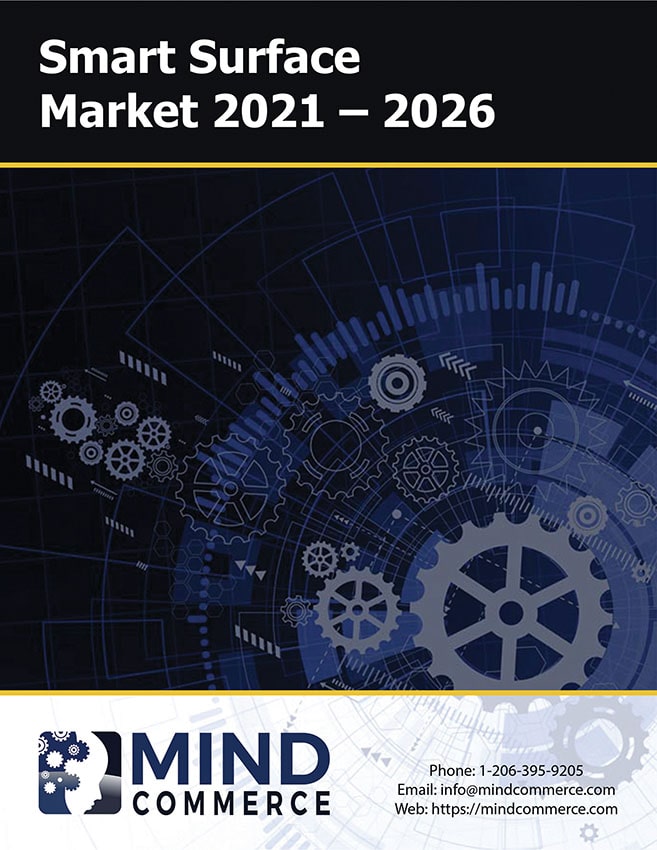Description
Smart surface technology refers to planar technologies that combine several technologies and technological approaches. Smart surfaces may be constructed with any material surface that re-arranges its morphology and/or composition as a means of enhancing functionality, such as the ability to respond to changes in the ambient environment. Smart surface market solutions will be many and varied, ranging from highly localized applications (such as heat dissipation) to those that have far-reaching impact such as their use in communications.
The use of smart surface solutions in network optimization cannot be overstated. In particular, Mind Commerce sees this as a critical development area in support of the 6G market. This is due to the fact that higher frequencies suffer from greater attenuation and thus network operators will be reliant upon solutions for signal propagation that involve more than simply deploying additional base stations. Smart surfaces will facilitate network optimization via self-adaptable and reconfigurable infrastructure that can modify radio signals between transmitters and receivers.
Smart Surface Market Dynamics
While largely in the R&D phase, smart surface market technologies will soon be productized for certain early adopter applications such as communications, heat dissipation, and various sensing solutions. Some leading companies are focused upon the formulation, application and characterization of easy-to-clean coatings as well as development of novel components, such as novel polymers, particles or hybrid materials.
Smart surface market materials/solution areas include:
- Self-Healing Materials
- Self-Cleaning Materials
- Self-Assembling Materials
- Self-Sensing Materials
- Integrated Photovoltaics Materials
- Anti-fouling Coatings
- Self-Dimming/Color Shifting Coating
- Self-Tinting Materials
Production of smart surface market components and finished products involves the integration of various technologies that are aggregated into materials to provide many benefits including sensing, temperature control, signal relay, and more.
Coating production for sensing optimization will be fine-tuned in accordance with the needs of industry verticals including construction, energy, transportation, medical and healthcare, electronics, military and security, and others. Solution areas for sensing include:
- Pressure
- Temperature
- Movement
- Presence/Occupancy
- Surface Tension
- Light
- Mechanical Force
- Ionic Strength
- pH Level
- Electromagnetic Fields
Smart Surface Market on Verticals
The anticipated expansion of smart surface market technologies is going to have a considerable impact on some industry verticals. The transportation industry will be a key beneficiary as smart surfaces are built into vehicles, roadways, railways, and more. The use of anti-microbial surfaces in the medical and healthcare sector is also another major growth factor for smart surface market.
The communications industry will also benefit from the smart surface market as solutions will facilitate self-adaptable and/or reconfigurable materials that can modify radio signals between transmitters and receivers. This will enhance capacity, coverage, and security. It will also create opportunities for future applications such as positioning, localization and embedded computing/intelligence. The addition of reconfigurable feature/functionality creates an opportunity to offer wireless-on-demand as a service.
Network Optimization for 5G and Beyond will rely upon the Smart Surfaces Market
Future radio access networks will be highly distributed, flexible (configurable and adaptable), and software-based. RANs will be able to adapt to the environment, network and user needs, which will be both humans and machines in the case of automation and IoT solutions. To accomplish this goal, the smart surface market for telecommunications and IT will leverage software-defined reconfigurable metasurfaces, controlled by integrated electronics involving edge computing and artificial intelligence.
Smart Surface Market Deployment and Evolution
Mind Commerce sees smart surface market materials initially being placed onto existing facilities such as factory walls, buildings and other assets. Over time, smart surfaces will be integrated into manufacturing and building materials. Accordingly, the smart cities market will benefit greatly.
In enterprise environments, personnel will become increasingly less aware of the presence of smart surfaces as they will be prefabricated as part of walls, desks, etc. Smart surface technologies will also accelerate the growth of IoT technology including intelligent devices, connected machines, connected robots, and various types of connected equipment.
Looking beyond smart surfaces on infrastructure, there is also a very human and highly personalized aspect of the smart surface market. There are many opportunities for human-machine interactions with smart surface market solutions as they may be constructed/configured to be sensitive to various stimuli such as touch, pressure, temperature, mechanical forces, and others.
The combination of smart surfaces and wearable technologies make it possible to read biometric information directly from the skin, conforming to the patient’s body, providing a combination of data and comfort that was previously impossible.
Smart Surface Market Report
This report evaluates the smart surface market including an assessment of current trends, market drivers and challenges, standardization efforts and the relationship with other technologies and solutions areas. The report analyzes smart surface market potential in residential, commercial, industrial, and government segments. It also provides forecasts by monetary value and volume for the global and regional smart surface market from 2021 to 2026.
The report also assesses products and materials by category such as the types of coating and sensing used with smart surface technology. This is also evaluated with respect to potential applications in various sectors including residential, commercial, industrial, and government sectors. The report also provides exclusive recommendations for stakeholders. For example, the report evaluates the role and importance of the smart surface market upon the 6G market.






